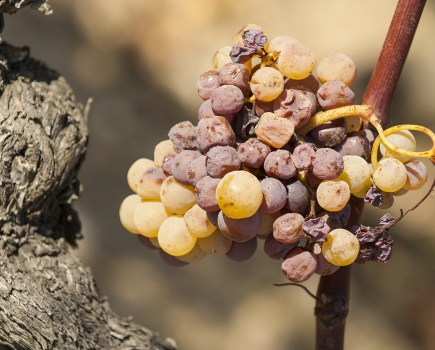Digital mapping could play an increasingly important role in future vineyard agronomy, so in this issue we talk to Kent grower Clive Baxter and his Hutchinsons agronomist Bob Little to hear how they have used such technology.
Farming on Kent’s Greensand Ridge can be very challenging given the undulating topography and varied soils, according to Mr Baxter, managing director at the 120 ha Westerhill Farm.
The business grows mainly tree fruit, including apples, pears, plums, apricots, cherries and quince, but four years ago added 10 ha of vines, predominantly Chardonnay, Pinot Noir, Pinot Meunier, and Alberino, on contrasting parts of the farm.
“We’ve got one block of vines on Weald clay on lower ground, and others growing up on the Greensand where there’s sandy silt, clay silt and considerable variation within a very small area.”
Such variability is the ideal proving ground for Hutchinsons’s Terramap high definition soil scanning. Mr Baxter won a prize to get his whole farm Terramapped in 2019, and believes it has been worthwhile, highlighting several factors that influenced subsequent management decisions.
Mr Baxter’s Terramap package focussed on measuring three key nutrients (P, K, Mg), pH, soil texture properties (clay, sand, silt %) and elevation, with results analysed using Omnia – more detailed Terramap service levels are available (see omniadigital.co.uk/our-services/terra-map).
Topography mapping
One of the most useful results for the vines was the elevation mapping, said Mr Baxter. This has helped determine where to plant vines in the future, and how to orientate planting patterns on the sloping ground.
“In one 1.5 ha field we’re planting next spring, we’ve decided to orientate rows southwest-northeast, rather than north-south, as this follows the contours better and should hopefully make tractor work easier on the steep slopes. In the orchard that preceded it, we sometimes used to run into trouble sliding across the slope.”
On another area, elevation mapping is being used to design new planting away from lower-lying areas prone to frost. In one field, altitude contours clearly highlighted a potential frost pocket, despite it being hard to spot visually. “We’ve increased the size of the reservoir next to it and filled in the hollow to reduce the frost risk.”
Adjusting pH
Another useful aspect is Terramap’s pH mapping, especially given the farm’s variable soils, said Mr Baxter.
“We’ve sometimes got high acid levels where you don’t expect it, i.e. on the Greensand. Our pH range is generally between 5.5 and 8, but you can get 5s in the middle of an 8. That’s where Terramap and Omnia has been really useful for highlighting these anomalies you wouldn’t find with conventional soil sampling.”
Mr Baxter acknowledges that without variable rate technology on his Vicon fertiliser spreader, it is hard to tailor soil amendments as precisely as Terramap and Omnia application plans suggest, so instead, he blocks land into areas of similar pH and manually manages those areas. Low pH is addressed with lime or calcified seaweed according to soil requirements.
“Calcified seaweed is a lot easier for us to address hotspots with because it goes through our fertiliser spreader,” he said.
He has also experimented with planting more vigorous rootstocks in high pH areas, although admits that where there is a mix of rootstocks (e.g. SO4, Fercal, 3309 C), he has not yet seen significant differences in vigour or yield. “These vines are only four years old though, so over a longer time we might see differences appear.”
Nutrient variations
One issue that showed itself when Mr Baxter planted his vines was their sensitivity to magnesium deficiency, something that had not been an issue in fruit trees.
“On the Greensand we have naturally high potassium, which was increased by the green compost applied when planting the vines. Where soil potassium was excessive, we saw magnesium deficiencies occur as potassium was locking up the magnesium.”
He has therefore applied magnesium to some areas to balance the potassium:magnesium ratio and is able to use Terramap to help identify potential problem areas.
“For me as an agronomist, if we’ve got a variety that’s showing leaf issues, with many potential causes, we need every tool we can get to eliminate factors from the equation so we can concentrate on the real causes,” notes Mr Little.
“If you’re going to make a vineyard profitable, you’ve got to get yield conformity over the whole area. The only way to do that on a varied site like Clive’s is with the help of a tool like Terramap. You will never get the same level of accuracy by relying on conventional soil sampling with an auger.”




